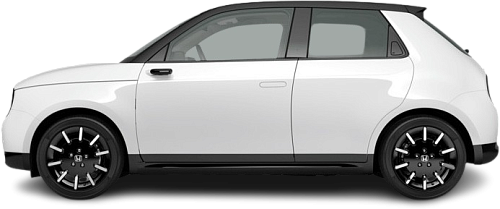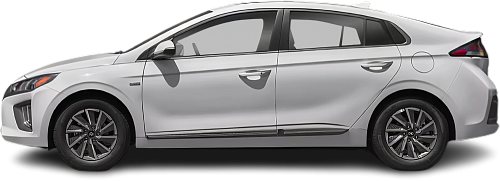Global EV Comparison: Honda e Advance vs Hyundai Ioniq Electric Gen 2
Struggling to Decide? Let AI Help!
Your AI Summary Is Ready!
General Info
Since both vehicles have been discontinued, they are now only available on the used car market. You can get the Honda e Advance (2020-2023) for as low as €16900, while the Hyundai Ioniq Electric Gen 2 (2019-2022) begins at €14900.
The Honda e Advance (2020-2023) is a Hatchback, whereas the Hyundai Ioniq Electric Gen 2 (2019-2022) is a Liftback.
| Property | Honda e Advance | Hyundai Ioniq Electric Gen 2 |
|---|---|---|
| Years of Production | 2020-2023 | 2019-2022 |
| Current Status | Discontinued | Discontinued |
| Country of Manufacture | Japan | South Korea |
| Body Style | Hatchback | Liftback |
| Market Availability | EU | EU, USA |
| Price Europe (Used) | €16900 | €14900 |
| GCC Score | 4.7 | 5 |
Range and Efficiency
The Hyundai Ioniq Electric Gen 2 (2019-2022) boasts a greater real-world range, a larger battery, and superior energy efficiency compared to the Honda e Advance (2020-2023).
| Property | Honda e Advance | Hyundai Ioniq Electric Gen 2 |
|---|---|---|
| Range (EPA) | - Range (EPA) | 274 km |
| Range (WLTP) | 222 km | 311 km |
| Range (GCC) | 189 km | 262 km |
| Battery Capacity (Nominal) | 35.5 kWh | 40.4 kWh |
| Battery Capacity (Usable) | 28.5 kWh | 38.3 kWh |
| Efficiency per 100 km | 15.1 kWh/100 km | 14.6 kWh/100 km |
| Efficiency per kWh | 6.63 km/kWh | 6.84 km/kWh |
| Range and Efficiency Score | 5.8 | 6.4 |
Charging
Both vehicles utilize a standard 400-volt architecture.
The Honda e Advance (2020-2023) offers faster charging speeds at DC stations, reaching up to 46 kW, while the Hyundai Ioniq Electric Gen 2 (2019-2022) maxes out at 44 kW.
The Hyundai Ioniq Electric Gen 2 (2019-2022) features a more powerful on-board charger, supporting a maximum AC charging power of 7.2 kW, whereas the Honda e Advance (2020-2023) is limited to 6.6 kW.
| Property | Honda e Advance | Hyundai Ioniq Electric Gen 2 |
|---|---|---|
| Max Charging Power (AC) | 6.6 kW | 7.2 kW |
| Max Charging Power (DC) | 46 kW | 44 kW |
| Architecture | 400 V | 400 V |
| Charge Port | CCS Type 2 | CCS Type 2 |
| Charging Score | 3.6 | 3.9 |
Performance
The Honda e Advance (2020-2023) is rear-wheel drive, while the Hyundai Ioniq Electric Gen 2 (2019-2022) offers a front-wheel drive system.
The Honda e Advance (2020-2023) boasts greater motor power and accelerates faster from 0 to 100 km/h.
| Property | Honda e Advance | Hyundai Ioniq Electric Gen 2 |
|---|---|---|
| Drive Type | RWD | FWD |
| Motor Type | PMSM | PMSM |
| Motor Power (kW) | 113 kW | 100 kW |
| Motor Power (hp) | 152 hp | 134 hp |
| Motor Torque | 315 Nm | 295 Nm |
| 0-100 km/h | 8.3 s | 9.7 s |
| Top Speed | 145 km/h | 165 km/h |
| Performance Score | 3 | 2.9 |
Dimensions
The Hyundai Ioniq Electric Gen 2 (2019-2022) is longer and wider, but the Honda e Advance (2020-2023) is taller.
The Hyundai Ioniq Electric Gen 2 (2019-2022) boasts a more extended wheelbase.
| Property | Honda e Advance | Hyundai Ioniq Electric Gen 2 |
|---|---|---|
| Length | 3894 mm | 4470 mm |
| Width (with Mirrors) | - Width (with Mirrors) | 2045 mm |
| Width (w/o Mirrors) | 1752 mm | 1820 mm |
| Height | 1512 mm | 1450 mm |
| Wheelbase | 2538 mm | 2700 mm |
Cargo and Towing
The Hyundai Ioniq Electric Gen 2 (2019-2022) provides more cargo capacity, featuring both a larger trunk and more space with the rear seats folded.
Neither car is equipped with a frunk (front trunk).
Neither vehicle is officially rated for towing in in the EU.
| Property | Honda e Advance | Hyundai Ioniq Electric Gen 2 |
|---|---|---|
| Number of Seats | 4 | 5 |
| Curb Weight | 1595 kg | 1602 kg |
| Cargo Volume (Trunk) | 171 l | 357 l |
| Cargo Volume (Max) | 861 l | 1417 l |
| Cargo Volume (Frunk) | - Cargo Volume (Frunk) | - Cargo Volume (Frunk) |
| Towing Capacity | - Towing Capacity | - Towing Capacity |
| Cargo and Towing Score | 3.8 | 4.1 |




